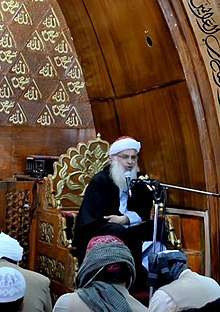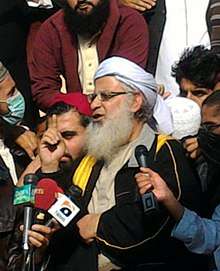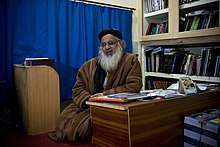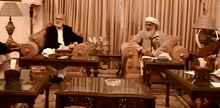Abdul Aziz (Pakistani cleric)
| Abdul Aziz Ghazi | |
|---|---|
 | |
| Born | January 10, 1963 |
| Residence | Islamabad, Pakistan |
| Nationality | Pakistan |
| Occupation | Chancellor Of Jamia Hafsa And Imam Of Lal Masjid, Islamabad |
| Known for | Pro-Taliban Sermons |
| Children | Hassan Ghazi |
Abdul Aziz Ghazi (Urdu: محمد عبد العزيز) is a Pakistani cleric and khateeb (sermon giver) in the central mosque of Islamabad known as Lal Masjid, which was the site of a siege in 2007 with the Pakistani army. Aziz was released from custody by the Pakistani supreme court in 2009 and acquitted in 2013. Besides Being The Imam Of Lal Masjid, Islamabad He Is Also The Chancellor Of Jamia Hafsa
In 2014, Aziz named a library at one of the mosque's seminaries after Osama Bin Laden[1]

Background
| Part of a series on |
| Deobandi movement |
|---|
| Ideology and influences |
| Founders and key figures |
| Notable institutions |
| Centres (markaz) of Tabligh |
| Associated organizations |
Aziz came to Islamabad as a six-year-old boy from his home town in Punjab, when his father was appointed khateeb of Lal Masjid in 1966. He grew up in Islamabad. Aziz is the son of Muhammad Abdullah, the first prayer leader of Lal Masjid, and elder brother of Abdul Rashid, who was killed in a government raid.
Aziz is descended from Sadwani clan of Mazari tribe in the town of Rojhan at the border of southern Punjab and Balochistan. Pakistan's military ruler, General Zia-ul-Haq, was said to be very close to Abdullah.
Education
After studying for few years in a public school, he was later sent to Karachi to study in a religious seminary. He is a graduate of Jamia Uloom-ul-Islamia Banuri Town, a Madrassah in Karachi, where he studied the customary Dars-e-Nizami, which is taught at the most elementary level of religious education in Pakistan.
After Graduating, The Government Appointed Him As Imam Of Islamabad's Mujaddiya Masjid In Sector F-8/2 , Where He Led Prayers Up Till (His Father) Maulana Abdullah Ghazi's Assassination in 1998

Lal Masjid
Abdul Aziz served as officially designated prayer leader in Lal Masjid From 1998 until 2005 when he was dismissed from service (but never removed) after he issued a "fatwa" (religious decree) against the army officers who were fighting against the Taliban and their supporters in the tribal areas close to the Afghan border. In the fatwa he declared that none of the army officers who were killed in the fighting in tribal area was a martyr and religious sanctions were not available for their funeral. His fatwa irked the government and he was dismissed from service. But in fact, the government has not attempted to remove him from his post. A replacement cleric was appointed for Lal Masjid, but local Residents refused to pray behind anyone other than Aziz.
He closely followed the supreme leader of the Taliban, Mullah Omar, and typically resisted being photographed.
Tensions between the government and religious students led by Abdul Aziz had simmered over the demolition of mosques. However, Islamabad was shaken out of its political stupor by the female students and teachers of the seminary in the last week of March. They announced the launch of a "moral drive" against all "immoral activities" in the federal capital.
He also warned the government of attacks in the case of a violent police operation launched against the seminary. "If the government fails to eradicate all these moral evils from the society within the specified period of one month the students of the seminary would themselves take actions against all the people involved in such activities," said Abdul Aziz while addressing Friday Prayer congregation at Lal Masjid.[2]
In his speech the cleric declared drugs, music, movies, and photographs of women as moral evils.
Final Showdown
The Lal Masjid brigade came to public notice when they kidnapped women (who they accused of being prostitutes) from Islamabad's residential areas and then later kidnapped several police officers. The brigade increased their activities and took to the crime of kidnapping Chinese workers from massage centres. This particular event created international pressure on Pakistan, especially from the Chinese government.
On 3 July 2007, the standoff with the government ended in bloody gun battles in which more than 1,000 Students were killed and scores wounded.[3]
on 4 July 2007 at 8.05, Aziz was arrested while leaving the complex disguised in a burqa. , the reason for his cross-dressing escape was Latter Revealed To be that he was called 'by a senior official of an intelligence agency with whom he has been in touch for a long time' (Aziz admitted that he and his brother Ghazi had done this many times before when they were declared wanted by the government). Since this man could not enter into the mosque to meet him. He asked Maulana Aziz to come down to Aabpara police station, situated on a walking distance from the mosque and asked him to wear a burqa to avoid identification.[4]
Release
Aziz was released on 16 April 2009 by the Pakistani supreme court as he awaited trial on Alleged charges of murder, incitement, and kidnapping. He was greeted by throngs of supporters.[5]
Since 2001, 27 different cases have been filed unsuccessfully against him.[6]

References
- ↑ Ahmed, Munir (18 April 2014). "Pakistani madrassa names library after bin Laden". U.S. News & World Report. Retrieved 22 October 2015.
- ↑ Farooq, Umer (7 April 2007). "Religious Cleric Threatens Suicide Attacks". OhmyNews International. Archived from the original on 5 March 2016. Retrieved 22 October 2015.
- ↑ Walsh, Declan (4 July 2007). "Red Mosque leader attempts to flee in burka". The Guardian. Retrieved 22 October 2015.
- ↑ http://www.atimes.com/atimes/South_Asia/IG07Df01.html
- ↑ Walsh, Declan (17 April 2009). "Red Mosque siege leader walks free to hero's welcome". The Guardian. Retrieved 14 November 2010.
- ↑ Asad, Malik (24 September 2013). "Lal Masjid cleric acquitted in all cases". Dawn News. Retrieved 22 October 2015.